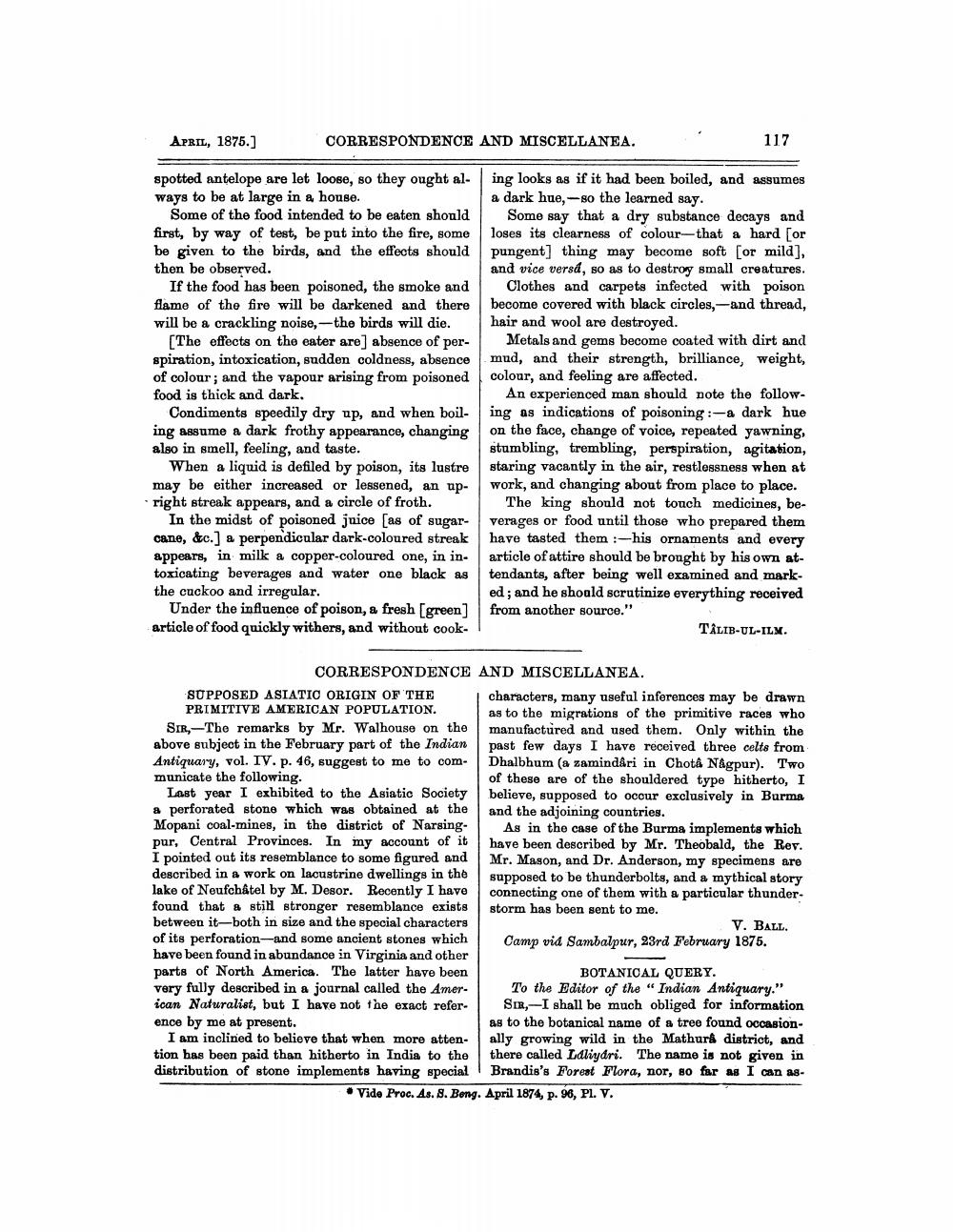________________
CORRESPONDENCE AND MISCELLANEA.
APRIL, 1875.]
spotted antelope are let loose, so they ought al- ing looks as if it had been boiled, and assumes ways to be at large in a house. a dark hue,-so the learned say.
Some of the food intended to be eaten should first, by way of test, be put into the fire, some be given to the birds, and the effects should then be observed.
Some say that a dry substance decays and loses its clearness of colour-that a hard [or pungent] thing may become soft [or mild], and vice versa, so as to destroy small creatures.
Clothes and carpets infected with poison become covered with black circles,-and thread, hair and wool are destroyed.
Metals and gems become coated with dirt and mud, and their strength, brilliance, weight, colour, and feeling are affected.
An experienced man should note the following as indications of poisoning:-a dark hue on the face, change of voice, repeated yawning, stumbling, trembling, perspiration, agitation, staring vacantly in the air, restlessness when at work, and changing about from place to place.
The king should not touch medicines, beverages or food until those who prepared them have tasted them :-his ornaments and every article of attire should be brought by his own attendants, after being well examined and marked; and he should scrutinize everything received from another source."
If the food has been poisoned, the smoke and flame of the fire will be darkened and there will be a crackling noise,-the birds will die.
[The effects on the eater are] absence of perspiration, intoxication, sudden coldness, absence of colour; and the vapour arising from poisoned food is thick and dark.
Condiments speedily dry up, and when boiling assume a dark frothy appearance, changing also in smell, feeling, and taste.
When a liquid is defiled by poison, its lustre may be either increased or lessened, an upright streak appears, and a circle of froth.
In the midst of poisoned juice [as of sugarcane, &c.] a perpendicular dark-coloured streak appears, in milk a copper-coloured one, in intoxicating beverages and water one black as the cuckoo and irregular.
Under the influence of poison, a fresh [green] article of food quickly withers, and without cook
CORRESPONDENCE AND MISCELLANEA.
SUPPOSED ASIATIC ORIGIN OF THE PRIMITIVE AMERICAN POPULATION.
SIR,-The remarks by Mr. Walhouse on the above subject in the February part of the Indian Antiquary, vol. IV. p. 46, suggest to me to communicate the following.
Last year I exhibited to the Asiatic Society a perforated stone which was obtained at the Mopani coal-mines, in the district of Narsingpur, Central Provinces. In my account of it I pointed out its resemblance to some figured and described in a work on lacustrine dwellings in the lake of Neufchâtel by M. Desor. Recently I have found that a still stronger resemblance exists between it-both in size and the special characters of its perforation-and some ancient stones which have been found in abundance in Virginia and other parts of North America. The latter have been very fully described in a journal called the American Naturalist, but I have not the exact reference by me at present.
I am inclined to believe that when more attention has been paid than hitherto in India to the distribution of stone implements having special
117
TALIB-UL-ILM.
characters, many useful inferences may be drawn as to the migrations of the primitive races who manufactured and used them. Only within the past few days I have received three celts from Dhalbhum (a zamindâri in Chotâ Nagpur). Two of these are of the shouldered type hitherto, I believe, supposed to occur exclusively in Burma and the adjoining countries.
As in the case of the Burma implements which have been described by Mr. Theobald, the Rev. Mr. Mason, and Dr. Anderson, my specimens are supposed to be thunderbolts, and a mythical story connecting one of them with a particular thunderstorm has been sent to me.
V. BALL. Camp vid Sambalpur, 23rd February 1875.
Vide Proc. As. 8. Beng. April 1874, p. 96, Pl. V.
BOTANICAL QUERY.
To the Editor of the "Indian Antiquary." SIR, I shall be much obliged for information as to the botanical name of a tree found occasionally growing wild in the Mathurâ district, and there called Laliydri. The name is not given in Brandis's Forest Flora, nor, so far as I can as




